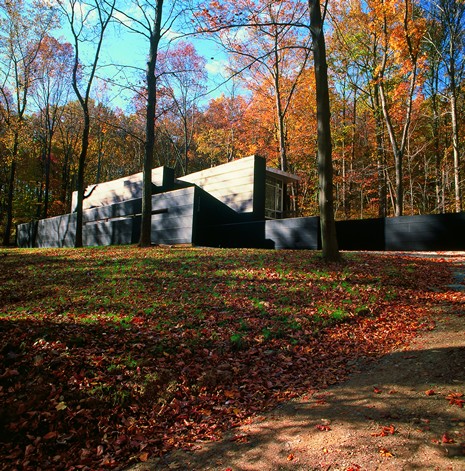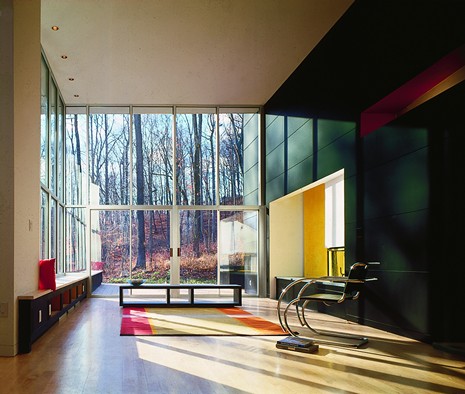Description
The plot used to belong to an iron mine producing cannonballs, set in what is now dense woodland; it had already been released for residential building purposes at an earlier stage. This meant that Kramer Woodard was able to design unencumbered building by rigid building regulations and build an unusual house for a single person on this attractive site not far from the nearest small place. The client had asked for a combined living and dining area with adjacent kitchen; this was all to be linked with the outdoor space by generous terraces, as the intention was that regular parties should be held here. The programme also included a main bedroom and two further bedrooms for flexible use, with separate bathrooms. Two garages in the basement storey face the drive, but the main entrance to the living area is from the rear via a large staircase at the back, which is a surprising feature.
Woodard designed a figure that develops parallel to the contours of the slope. Main rooms that reach out to the outdoor space and blend in with it are accompanied by servant ‘wall rooms’, parallel slabs that are strongly accentuated in terms of the body of the building. They divide the zones, dramatize the directed, track-like link between inside and outside and indicate the inherent mobile geometry with their polygonal contours. In fact, despite a very lively ground plan figure, the architect uses overlapping right-angled structures as an ordering principle. This apparent contradiction of an ordering dynamic allows Woodard to create tension between space and building. Overlapping, penetration and extension form the compositional basis of a form that is also shifted on the horizontal plane and thrusts outwards on both sides. Funnel-shaped spaces indicate the link with nature and the large transitional terrace areas. So the groups of woodland trees on the hilly terrain become the backdrop to an opulently staged spatial drama. The choice of anthracite-coloured cement slabs for the exterior cladding and a dark overall appearance is an aesthetic accent serving as a reminder of the iron ore that used to be mined here.
Drawings
Site plan
Building contours superimposed on orthogonal structures
Lower level with main entrance to the dining area with adjacent living area and transition to the kitchen; attached bedrooms with ancillary ‘wall rooms’ between
Upper floor with garages
Longitudinal section through the bedroom area with staggered levels to kitchen and terrace, living area as a view of the building from the outside
Photos

Exterior view of the building from the east

Interior view of the living area with terrace
Originally published in: Klaus-Peter Gast, Living Plans: New Concepts for Advanced Housing, Birkhäuser, 2005.